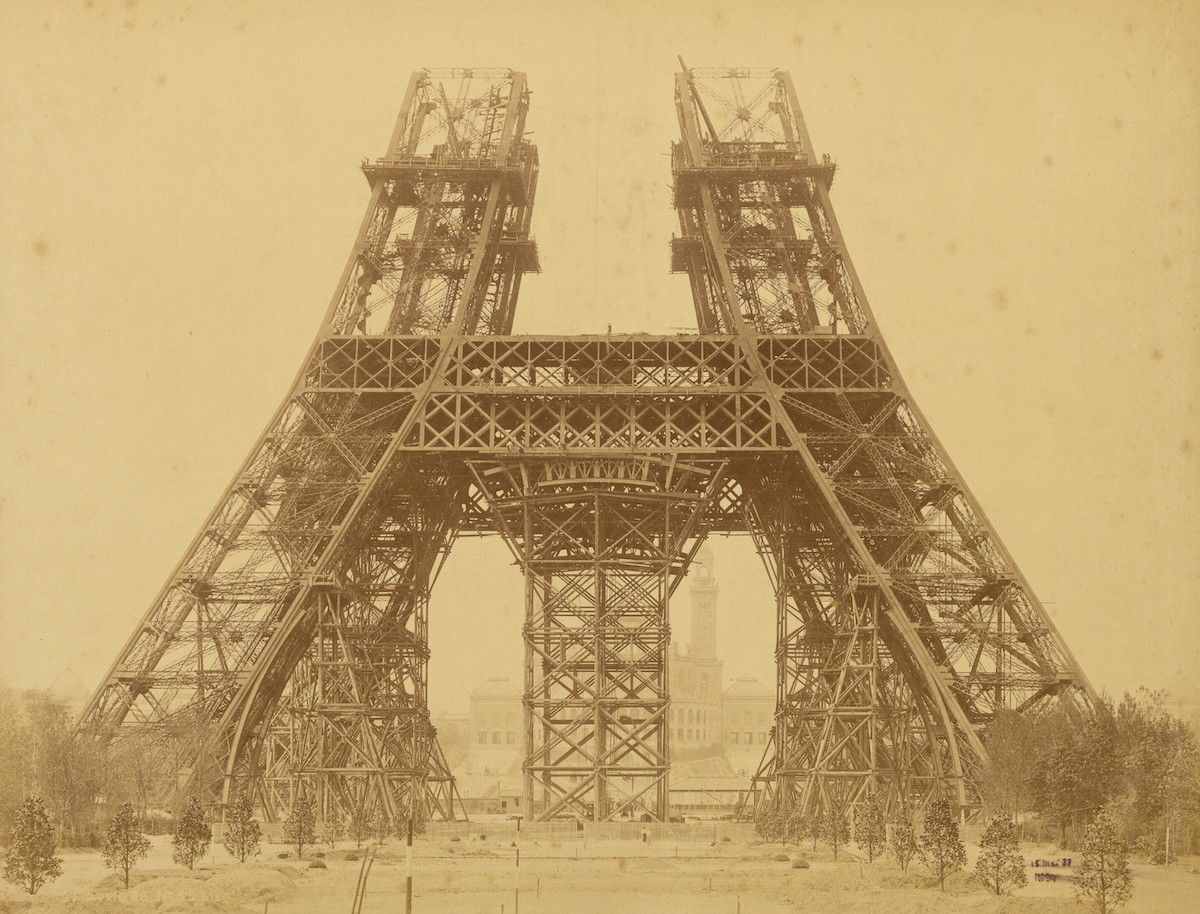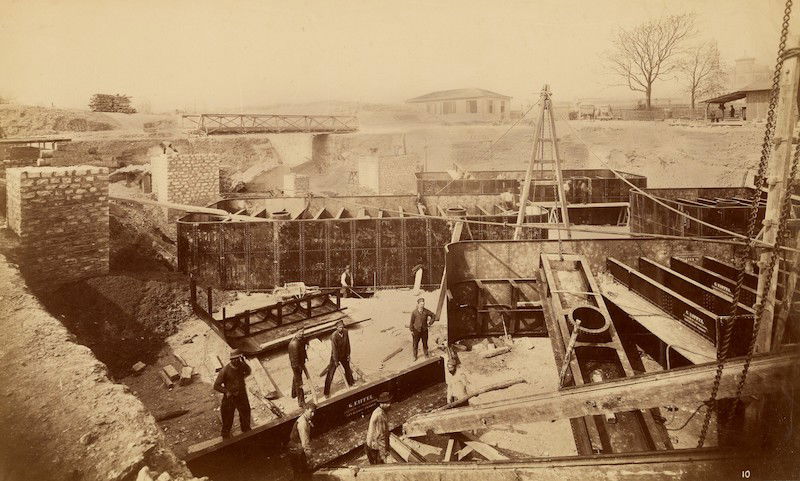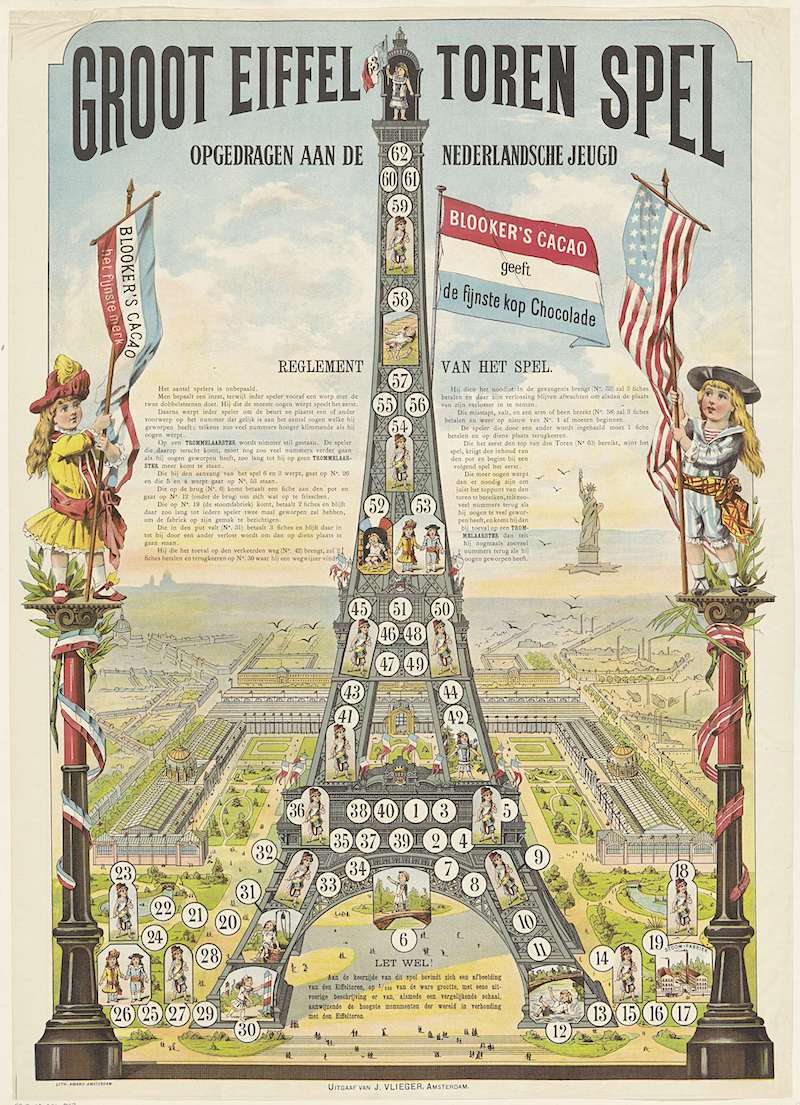The Controversial Construction of Eiffel’s Tower
Paris' most famous landmark is one of the world's great attractions, but the plans to build the Eiffel Tower raised a storm of protest at the time.

Without doubt, the 19th century was the heyday of great engineering works. It was an age when technical progress at last permitted the realisation of dreams, some of them centuries old: tunnelling beneath rivers and mountains, creating short cuts across the isthmuses between seas and oceans, or raising bridges across rivers and estuaries. A few undertakings, like the tunnel under the Channel, foundered on deeply ingrained prejudices; others ended in disaster (the Tay Bridge) or scandal (the Panama affair), because of miscalculations and embezzlement. Yet the achievements far outweighed the failures, as witnessed by Ferdinand de Lesseps and Gustave Eiffel, whose reputations were not lastingly affected by the Panama scandal, in which both of them were involved. The name of the first is indissolubly linked to the Suez Canal, that of the second to the 1,000-foot tower that was to be his most spectacular achievement.
Another feature of the last century, at least from 1851 onwards, was the creation of universal exhibitions that periodically gave the industrial countries an opportunity to show off their products and their technical expertise. At times this was most convincingly demonstrated in the palaces, galleries and halls housing the exhibition, or in the monument that served as its landmark. The use of iron allowed large structures to be speedily erected (thanks to prefabrication techniques), then dismantled once the exhibition was over. Some of the finest examples of this architecture, ephemeral by design, have vanished: the Crystal Palace, transferred to Sydenham, then destroyed by fire; and the Galerie des Machines of 1889, its huge nave demolished after twenty years. But the tower, constructed during the Third Republic as a brilliant commemoration of the centenary of the French Revolution, has just celebrated its own hundredth birthday. So it is no accident that the past year has been a nest of anniversary dates on the other side of the Channel. The tower which bears the name of its builder (a signal honour), has become a familiar feature of the Parisian scene, yet it was not automatically granted droit de cite'.

When Gustave Eiffel (1832-1923) took over the plans for the construction of a 1,000-foot iron tower, submitted to him by two of his colleagues (Maurice Koechlin and Emile Nouguier), the concept was not, strictly speaking, original. We do not need to go hack as far as Babel: in 1832, Richard Trevithick had suggested commemorating the passage of the Reform Bill with a circular tower made of cast iron, inside which a piston driven by compressed air would propel visitors from the base to the summit, like corks from a popgun. No doubt fortunately, this scheme was to remain on paper. The idea was later taken up by the American engineers Clarke and Reeves for the Philadelphia Exhibition of 1876 and, a few years later, by two French architects, Sebillot and Bourdais, who suggested building a tower topped by a lighthouse which, according to them, would be powerful enough to illuminate every corner of Paris.
Though the suggestion (if nothing more) had been raised, a structure of such staggering height aroused feelings of distrust and even of dismay when Eiffel was commissioned to build it. It was not that anyone doubted the ability of an engineer who had proved himself, among other things, in the construction of wide-spanned bridges (over the Douro, the Tardes, the Truyere and so on). Actually his prospective tower was the direct outcome of engineering feats like the viaduct of Garabit, just as the Crystal Palace was the offshoot of Paxton's greenhouses. But concern was vented from various quarters, with fears that the combined effects of wind and vertigo would decimate the workers of this aerial site; that a sharp gust might bring down the tower while it was under construction; and, finally, that visitors to the completed work would be struck by lightning during a thunder-storm or that electricity discharged from the tower into the nearby waters of the Seine might electrocute the fish – to the great dismay of anglers. Eiffel tried to overcome these fears which he described as 'fanciful': 'it is completely wrong', he proclaimed, 'to imagine that a tendency to vertigo increases with height'. And he reminded his critics of all the measures he had taken to ensure the safety of his teams, who were, in any case, inured to working 300 or 400 feet above the ground. In the event, there was to be no serious accident while the site was in operation (except for one fatality outside working hours). In addition, Eiffel decided that he would become solely responsible for all risks and penalties should any mishap occur, in order to cut short an action being brought, even before the start of work, by a householder living close to the Champ de Mars: the man was afraid that his property would be bombarded with nuts and bolts, and tools that had slipped out of the workmen's frozen hands.
However, it was not until work had already started on digging the foundations that the loudest clamour was raised against the tower. This was the manifesto published in Le Temps on February 14th, 1887, and entitled: 'Protestation des artistes'. Among its forty- seven signatories were the names of the painters Leon Bonnat, William Bouguereau and Ernest Meissonier, the musician Charles Gounod, the architect of the Paris Opera Charles Garnier, and the writer Guy de Maupassant, together with some lesser literary figures. Like Joseph Paxton's detractors before them (Paxton's building was 'neither crystal, nor a palace', according to Leigh Hunt), these enraged artists based their criticism mainly on aesthetic considerations:
We wish – authors, painters, sculptors, architects, enthusiastic lovers of beauty, which has hitherto been respected in Paris – to protest with all our energy, and with all the indignation of which we are capable, in the name of art and French history now menaced, against the erection in the heart of our capital of the useless and monstrous Eiffel Tower... For the Eiffel Tower, which even the mercantile United States would not countenance, surely dishonours Paris... No- thing further is wanting to prove the justice of what we say than to imagine for an instant this tower dominating Paris, like a gigantic black factory chimney, crushing with its barbarous mass Notre-Dame, the Sainte-Chapelle, the Tour Saint-Jacques, the Louvre, the Dome of the Invalides, the Arc de Triomphe; all our monuments humiliated, all our architecture shrunken, and disappearing affrighted in this bewildering dream. And during twenty years i.e. the length of the concession we shall see, stretching over the entire city... like a black blot, the odious shadow of the odious column built up of riveted iron plates…

There was no appeal against this verdict, but Gustave Eiffel, demonstrating a cast-iron belief in his enterprise, was able to reply tactfully and aptly to these self-appointed arbiters of French taste. And the most telling argument that he could offer them was the consensus of public opinion that the tower steadily gained, step by step with the mathematical regularity of its construction.
The components, manufactured at the Eiffel workshops in Levallois-Perret, arrived ready for assembly. If a unit proved to be defective in any way, it was immediately returned to the factory and not, in any circumstances, repaired on site. The French press commented with some satisfaction on the differences between the methods adopted by Sir John Fowler and Benjamin Baker to erect their bridge over the Forth, and the high-precision work being carried out under the eyes of Parisians: on one hand a site transformed into a workshop with all the tools necessary for fitting, drilling, bending and reaming; while on the other, simply haulage gear, a few riveting benches and two hydraulic jacks. They rapturously commended the faultless organisation of the aerial site and the skill of Eiffel's engineers who, amongst other achievements, had perfected a special design of crane (Guyenet type) that moved vertically along the lift rails.
Two strikes among the workmen, each of short duration, were the only things to threaten the operation of this splendid mechanism. Sceptics and prophets of doom, anxious to detect the slightest threatening tremor on days when the shadow of the tower was picked out by strong sunlight, found they were wasting their time: there was neither accident nor delay during the period of construction. The tower was completed on schedule, in 635 days of actual work, as Eiffel himself pointed out.
In normal operation, the site did not employ more than 183 men, later joined by the painters hoisted into the iron lattice like sailors on the rigging of a ship. The components were given an undercoat of bright Venetian red at the factory, then two further coats once they were in place, the last being the final colour. This was a rich chocolate, the tone of which was lightened from the base towards the summit in order to accentuate the height of the monument and the effect of its vanishing into space. The painters also had the task of inscribing, in gold letters, the names of the scientists in homage to whom Eiffel wanted to dedicate the tower. Unfortunately, the panels that had been in- tended for this on the frieze at the first level were too small to accommodate comfortably surnames of more than seven letters, so the illustrious Lavoisier owed his place in the pantheon solely to the accident of having two I's in his name.
Inaugurated on March 31st, 1889, the tower was to have more than two million visitors during the 173 days of the exhibition. Most reigning monarchs declined the invitation to visit an event that they considered far too republican for their taste. The day (May 5th) originally scheduled for opening the exhibition was the anniversary of the State-General and, even more aggravating for foreign royalty, it happened to be also the anniversary of the death of Napoleon I. However, the Eiffel Tower attracted some notable visitors, among them the Prince and Princess of Wales, accompanied by their children., Mr and Mrs Gladstone; the Duke of Cambridge; and Thomas Edison, who inscribed the following in the livre d'or:
Top Eiffel Tower Sept. 10 1889
To M. Eiffel the Engineer the brave builder of so gigantic and original specimen of modern engineering from one who has the greatest respect and admiration for all Engineers, including the Great Engineer the Bon Dieu.
To satisfy the impulse of some visitors who had been inspired to write their names on the beams or to record the elevated thoughts appropriate to the location, sheets of paper were hung up on the third platform, and removed daily, covered with every sort of inscription. But these early examples of dazibao did not discourage the writing of graffiti. A contemporary journalist observed that the metal structures within the reach of tourists were literally covered with interlacing signatures and initials. Among these thousands of names or nicknames, he noted those of ‘Pauline la Toquee’ (Loony Pauline), 'Nini and Leon' in a heart and, rather less expected (and probably apocryphal), the signature of Lord Randolph Churchill (June 1889). This was no doubt the work of a practical joker, since it is hard to imagine the noble lord carving his name with a penknife.

The general public was infatuated and there was a veritable rash of scale models, knick-knacks, trinkets and other souvenirs in the shape of the tower. It even inspired odes, calligrammes, songs, waltzes, polkas and a symphony in which the movements corresponded to the stages of construction:
Arrival of the engineers and workmen on the Champ de Mars
(lento)
Start of work and building of foundations for the tower
(moderato)
Sound of ironworks (moderato e martellato)
The ironworkers
('allegro vivace)
Disturbance and unrest among the workers
(allegro agitato)
What made the 1889 exhibition different from its predecessors, was a greater emphasis on entertainment. Under attack from Boulangists, Bonapartists, monarchists and anarchists, the Third Republic was anxious that both Parisians and provinciais should forget politics and enjoy themselves. And, indeed visitors had more than enough to choose from: Charles Garnier's retrospective history of human dwellings, the Rue du Caire, with its exotic bazaars, donkey-drivers and belly-dancers, the magnificent painted panoramas, the globe showing the world on a scale of 1:1000000, the illuminated fountains, and much more.
These attractions were spread round the perimeter of the exhibition and visitors travelling from one to another rode the Decauville train in which there were notices advising the passengers to take care, in every language – except German. Germany, which had turned down the French invitation to take part, was the most prominent absentee from the international event and many could remember gawking at the enormous Krupp gun exhibited at the Paris Exhibition in 1867. It was a bitter memory, since the gun had since been used in less peaceful confrontations.
However, architecture remained the vital element and centre of attention at the exhibition. French and foreign newspapers devoted most of their reports to the Galerie des Machines and, above all, to the tower which, in the spirit of competition appropriate to these international events, had beaten both world records, for height and width.
Gustave Eiffel was to inspire many imitators seeking to equal, or even to exceed his performance. As early as 1890, the railway tycoon, Sir Edward Watkin, had organised a competition to build a rival to the Eiffel Tower in London. But the work, which started in Wembley Park, could not be completed because of lack of money. The challenge was constantly being taken up by other enterprising individuals, exemplified in the plans of the architect Faure-Dujarric who, in March 1934, unsuccessfully proposed building a second tower to defend Paris against air attack. His gigantic pylon, a full 6,600 feet in height, was to have included artillery emplacements and aircraft hangars.
To return to 1889: the veritable wave of 'Eiffelomania' that swept through the public, caused some of those who had signed the Protestation, like Gounod and Meissonier, to withdraw their opposition and make amends. Other early opponents stuck to their guns, suggesting that the tower be dismantled for the exhibition of 1900 or, less drastically, 'embellished' by cutting it off at the point where the four pillars met: they then proposed that the upper part should be replaced by a belfry, a globe or the gigantic statue of a naked woman. In the event, nothing was done except to change the colour of the Iron Lady's dress. The original reddish brown became a full range of yellows, varying from an orangey tint at the base to pale lemon at the summit. Subsequently, the lady was to remain solidly attached to her present ferrochrome attire, adopted in 1907 and regularly renewed.
Since the artists' outburst in 1887, writers, sculptors, photographers, filmmakers and, above all, painters have adopted what the Oxford Companion to French Literature persists in calling 'this intrinsically hideous erection'. Robert Delaunay paved the way in 1909 with his 'Red Eiffel Tower'. Moulding and dismembering it, Fauves, Cubists, Futurists, Nabis have displayed it in every shape and colour: red, blue, yellow or green, the tower asserts its presence in the canvasses of Chagall, Dufy, Pissarro and many others. Moreover, as Meyer Schapiro has brilliantly demonstrated, its structure bears a significant relationship to the technique of an artist like Seurat:
The construction of this immense monument out of small exposed parts each designed for its place, and forming together out of the visible criss-cross and multiplicity of elements a single airy whole of striking simplicity and elegance of shape was not unlike Seurat's own art with its summation of innumerable tiny units into a large clear form which retained the aspect of immaterial lightness evident in the smaller parts.
Failing the universal exhibition announced by President Francois Mitterrand on September 24th, 1981, the bicentenary celebrations have been more fragmented than those of the centenary. Here, one must emphasise the unifying role of French universal exhibitions, particularly in the last century. As prestige events, they allowed the country to confirm its place in international competition and came at an appropriate moment, mobilising the energies of the country after the crushing defeat of 1870, and strengthening the Third Republic which was faced with a country divided over Boulangist unrest and then the Dreyfus Affair. In London, as in Paris, the most memorable exhibitions are still associated with some supreme architectural monuments: the Crystal Palace, in 1851, and the Eiffel Tower in 1889. In a more general way, they all served to display the plans and achievements of civil engineering, and each provided an opportunity for engineers to show the public a new version of a fixed link over or under the Channel. Gustave Eiffel himself contributed working drawings for a submerged tunnel, curiously described as a 'submarine bridge'. Even today, when it is on the point of being realised, this scheme over which the engineers have racked their brains since the time of Napoleon, surely deserves its nickname of the 'Loch Ness monster of engineering'. By sheer coincidence, the tunnel is due to start operating in the year that marks the bicentenary of the Terror. The nest of anniversary dates is being replenished with new eggs.